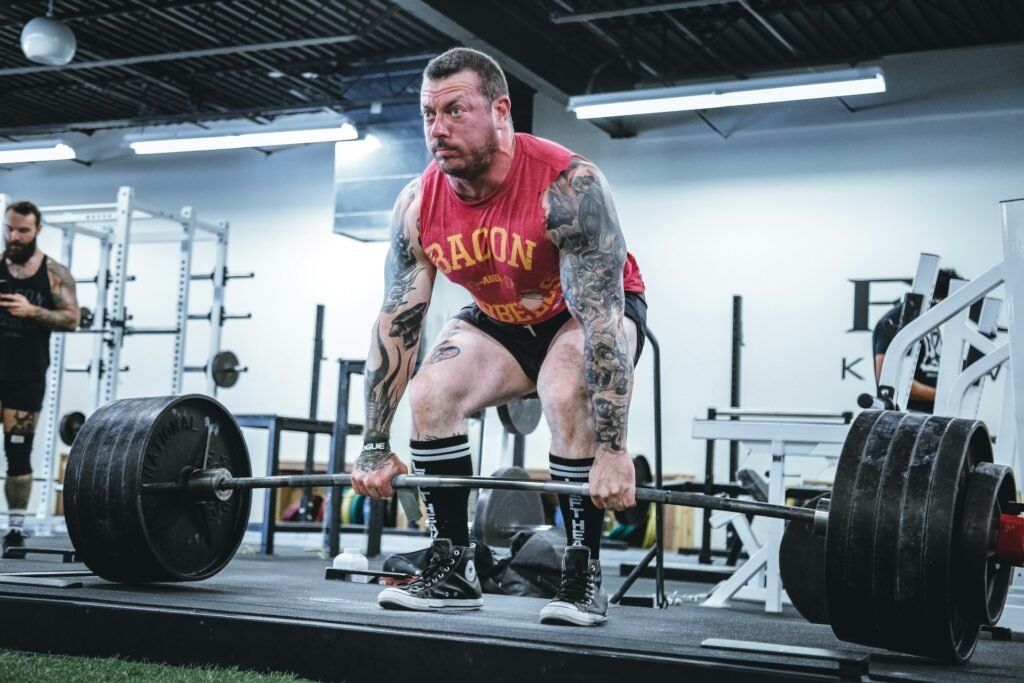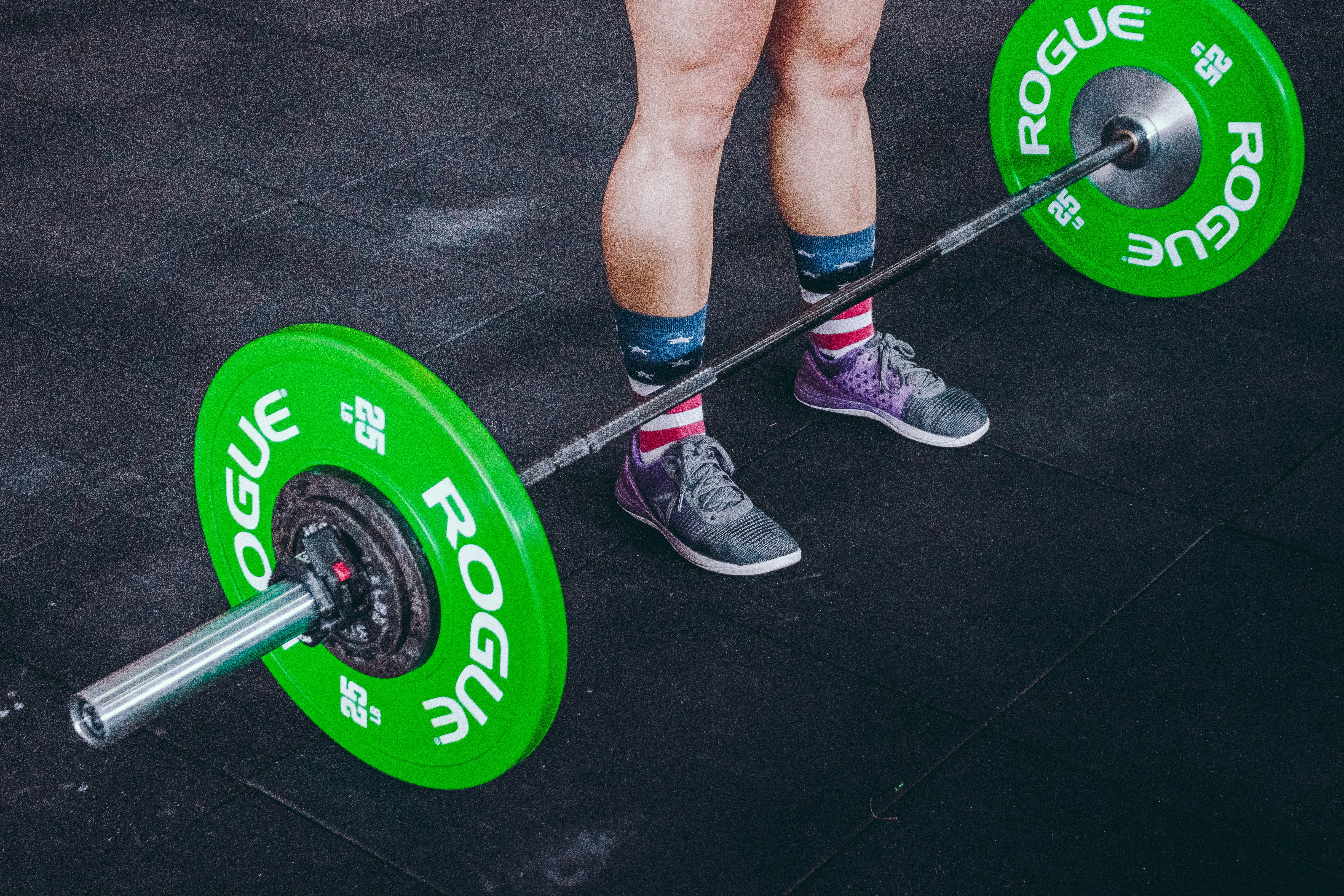
Photo by Alora Griffiths on Unsplash
The deadlift, often cited as the cornerstone of strength training, is a powerful full-body exercise. It targets multiple muscle groups, including the lower back, glutes, hamstrings, and core. The ability of the deadlift to build mass and enhance functional strength makes it a staple in any serious fitness regimen. Whether performed using a traditional barbell or a hex bar, the deadlift compels the body to move in a coordinated and powerful way.
Studies indicate that the deadlift is not only effective in building muscle but also in improving overall athletic performance (Muscle & Fitness). For example, competitive powerlifters using a hex bar were able to lift on average 50 pounds more than when using a barbell, while experiencing less stress on the lower back. This makes deadlifts versatile and adaptable to various training needs and goals.
It’s important to approach deadlifting with proper form to prevent injury and maximize effectiveness. Ensuring that the back remains straight and using the legs to lift are crucial techniques to follow. Novices often benefit from professional guidance or detailed, form-focused articles to get started correctly.
If you’re interested in improving your cardiovascular recovery rate post-deadlifting, you might find our article on cardio recovery rate useful.
What is a Hex Bar?

Photo by joe mcferrin on Unsplash
A hex bar, also known as a trap bar, is a specialized barbell designed for weightlifting exercises like deadlifts, squats, and shrugs. Unlike a traditional straight barbell, the hex bar is shaped like a hexagon, allowing the lifter to step into the center of it. This unique design helps distribute the weight evenly around the body, which can make lifting safer and more efficient.
One of the primary advantages of using a hex bar is its neutral grip, which mimics the natural orientation of your hands when carrying heavy objects. This grip minimizes stress on the shoulders and wrists, and helps maintain a more upright posture during lifts. Additionally, the hex bar’s design places less strain on the lower back, making it an excellent option for those with preexisting back issues.
Hex bars typically weigh around 50-60 pounds and can accommodate standard Olympic-sized bumper plates. This versatility allows for a range of exercises and weight increments, making it suitable for both beginners and advanced lifters.
According to Power Systems, a hex bar can help you perfect a hip-dominant deadlift that is easier on the joints, and allows you to lift heavier weights without compromising form. The bar’s design also enables you to engage different muscle groups, particularly the quadriceps, compared to traditional deadlifts which place more emphasis on the hamstrings and glutes.
If you’re interested in exploring various weightlifting tools, our article on barbell leg workouts might offer additional insights.
Advantages of Hex Bar Deadlifts
Hex bar, or trap bar, deadlifts offer several advantages over traditional barbell deadlifts, making them a valuable addition to your strength training routine.
- Heavier Lifts: The hex bar deadlift enables you to lift heavier weights compared to a traditional barbell. Most people experience a 5–10% increase in the weight they can lift with a hex bar, thanks to a more favourable center of gravity and better muscle work spread across different joints [source].
- Reduced Spine Stress: This type of deadlift puts less stress on your lumbar spine. Since the load is more centered and you can maintain a more upright torso position, it minimizes lower back strain, making it a safer option for those with back issues [source].
- Easier Form and Technique: The trap bar deadlift is easier for beginners to learn and perform correctly. The neutral grip and alignment of the bar with your body’s center make it easier to maintain proper form, reducing the risk of injury.
- Better Quadriceps Activation: Compared to the conventional deadlift, the hex bar deadlift involves more leg muscles, particularly the quadriceps. This makes it an excellent option for overall leg development if barbell squats are not part of your routine [source].
- Versatility in Handles: The hex bar often comes with high and low handles, offering flexibility for different body types and training levels. Beginners or taller individuals can start with the high handles and switch to the low handles as they advance, ensuring a varied and progressive workout.
For those who want a comprehensive approach to leg training, the trap bar deadlift can complement other movements like the Romanian Deadlift to build strength and muscle efficiently.
By incorporating hex bar deadlifts into your training program, you can take advantage of these benefits to develop a stronger, more resilient body.
What is a Barbell Deadlift?

Photo by Victor Freitas on Unsplash
The barbell deadlift is a foundational strength training exercise that targets multiple muscle groups, making it a staple in many fitness routines. This exercise involves lifting a loaded barbell from the ground to a standing position and then lowering it back down. The deadlift primarily works the quadriceps, glutes, hamstrings, and lower back, but it also engages the core muscles for stability.
To perform a barbell deadlift, stand with your feet hip-width apart and the barbell placed over your midfoot. Bend at your hips and knees to grasp the bar with an overhand grip, keeping your hands just outside your knees. Engage your core and maintain a neutral spine as you lift the bar by pushing through your heels, extending your hips and knees until you achieve an upright position. Reverse the movement to lower the bar back to the ground, ensuring you keep the weight close to your body throughout the lift.
According to the National Academy of Sports Medicine (NASM), proper form is crucial to avoid injury and maximize the effectiveness of the exercise. Common mistakes include rounding the back, overemphasizing the knee bend, and not maintaining the head and spine in alignment (NASM Article).
Deadlifting is known for its efficiency in building strength and muscular endurance. Research indicates that deadlifts can help improve overall body composition and even enhance athletic performance by boosting explosive power and functional strength. This makes the barbell deadlift an excellent choice for those looking to increase muscle mass and strength across multiple body parts.
For more detailed exercises and techniques involving barbells, you might find our article on back exercises with barbell very useful.
Advantages of Barbell Deadlifts
Barbell deadlifts are a cornerstone of strength training routines. They offer numerous benefits for fitness enthusiasts and athletes alike:
- Enhance Muscular Strength and Hypertrophy: Barbell deadlifts target major muscle groups, including the glutes, hamstrings, quadriceps, and lower back. Studies show that deadlifts can substantially increase strength and muscle size, particularly in the posterior chain (Healthline, 2023).
- Improved Functional Strength: The motion of a barbell deadlift mimics everyday activities such as lifting heavy objects from the ground. This makes it an excellent exercise for improving real-world functional strength.
- Boost Metabolic Rates: Engaging large muscle groups in compound movements like deadlifts can increase your metabolic rate. Resistance training exercises, such as deadlifts, are known to be an effective method for burning calories and increasing your metabolism (Healthline, 2023).
- Increase Bone Mineral Density: Regularly performing weight-bearing exercises such as deadlifts helps increase bone mineral density. This is particularly beneficial for older adults who are at risk of osteoporosis (Healthline, 2023).
- Versatility in Training: With various deadlift variations available, from conventional to Romanian, you can target different muscle groups and adapt your training to meet specific fitness goals.
- Core Activation: Deadlifts significantly engage the core muscles, including the external obliques, rectus abdominis, and erector spinae. This leads to enhanced core strength, which is crucial for overall stability and injury prevention (Healthline, 2023).
Incorporating barbell deadlifts into your fitness regime can yield substantial improvements in strength, functionality, and overall health. By consistently performing the exercise with proper technique, you can harness these benefits effectively.
For those looking to enhance their lower body strength even further, consider exploring our guide on effective leg workouts to complement your deadlift routine.
Comparative Research and Findings
Comparing the hex bar (trap bar) deadlift to the barbell deadlift reveals key differences and advantages for each, supported by research and practical observations.
Firstly, a significant study by Swinton et al. (2011) indicated that hex bar deadlifts result in a more vertical torso angle compared to traditional barbell deadlifts, reducing the stress on the lower back by 19-22% [^1^]. This makes the hex bar variation a safer alternative for individuals with lower back concerns while still engaging the core and leg muscles effectively.
Another crucial difference is in the muscle activation patterns. Research has shown that the hex bar deadlift tends to engage more quadriceps muscles, similar to a squat, whereas the barbell deadlift predominantly activates the posterior chain, including the hamstrings and glutes [^2^]. This variation allows lifters to target different muscle groups more precisely based on their fitness goals.
In terms of maximum load capacity, barbell deadlifts generally allow lifters to handle heavier weights, primarily because of the biomechanical advantage and the direct vertical lift path. Experienced lifters aiming to maximize their strength may thus prefer the barbell deadlift.
However, hex bar deadlifts show a reduced learning curve due to the more natural hand positioning and balanced center of gravity, which can be particularly beneficial for novice lifters. This makes the hex bar an excellent choice for those new to strength training or those focusing on general fitness.
For more in-depth insights on related topics, you might want to check our page on Barbell Leg Workouts.
[^1^]: Swinton, P. A., et al. “A Biomechanical Comparison of the Traditional Deadlift, the Squat, and the Sumo Deadlift.” https://en.wikipedia.org/wiki/Comparative_research [^2^]: Research findings on muscle activation during different deadlift techniques.
Final Thoughts on Deadlift Variations
Choosing the right deadlift variation can make a significant difference in your strength training routine. Both the hex bar and barbell deadlift offer unique benefits, and your choice should depend on your specific fitness goals and physical condition.
Research shows that the hex bar deadlift may be more beneficial for improving jump performance and high-velocity lifting compared to the traditional barbell deadlift. One study found that athletes could produce greater peak force, power, and velocity with a hex bar deadlift than with a straight bar [source]. This might make it a better option for athletes and beginners who need a lower risk of injury due to its more ergonomic lift pattern.
Conversely, the traditional barbell deadlift remains unparalleled for building raw strength, particularly in the posterior chain. This exercise targets the glutes, hamstrings, and lower back effectively, and studies indicate it also helps develop grip strength due to the extended range of motion and bar positioning.
Remember to consider your current fitness level and health condition. For example, if you have lower back issues, the hex bar might be a safer choice due to its more upright lifting position.
For further information on optimizing your exercise routine, you might find it helpful to explore our article on the benefits of Zone 2 cardio, which can complement your strength training by enhancing long-term cardiovascular health.
Ultimately, the best approach is to incorporate a variety of deadlift variations into your program. This way, you can benefit from the unique advantages each one offers and better address your overall fitness goals.